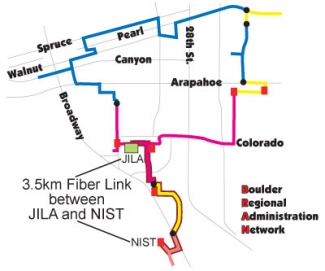Scientists in Fellow Jun Ye's lab are developing a high-precision optical atomic clock linked to super-narrow optical transitions in ultracold, trapped strontium atoms. However, unless the new clock is portable (it is not) or researchers figure out how to accurately transmit its clock signal over a fiber optic network to NIST, the legendary strontium clock will not be able to help the world keep better time. Recently, Kevin Holman (who received his Ph.D. in physics from CU in August), graduate student Darren Hudson, and Ye figured out how to accurately send a frequency reference linked to the clock on a round trip over the fiber network that links JILA with NIST. When the researchers measured the signal upon its return, they found it to be at least ten times more stable than what has ever been achieved for transmitting clock signals over similar distances. This was no small accomplishment considering that the fiber optic cable is buried under Boulder city streets, where it is sensitive to traffic noise and variations in temperature.
"You can tell when it's rush hour by how noisy the signal gets," Kevin said.
Undeterred, Kevin and his colleagues designed a "noise-cancellation servo" using an adjustable delay line. This device can change the path length of the transmitted signal to cancel out fiber noise due to road sounds and temperature changes. In their first experiment, they encountered a limit in how fast they could adjust the delay line. However, they are already working on a new idea to increase the speed of the noise-cancellation servo. They are also working toward designing new techniques for more sensitively detecting the noise introduced during transmission. They plan to use all-optical techniques to measure the arrival times of the transmitted clock "ticks," instead of converting the transmitted optical signal to an electronic signal first. This technique will eliminate the noise currently introduced by the radio-frequency amplifiers in the noise-detection system. The group aims to improve the stability of signal transmission at least another tenfold to ensure that time can travel as accurately as the new strontium clock can measure it.
The time travel work was reported in the May 15 (2005) issue of Optics Letters. Earlier work leading up to the latest results was reported in the July (2003) issue of the Journal of the Optical Society of America B and the July 1 (2004) issue of Optics Letters. - Julie Phillips




